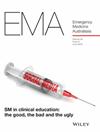Rate, Mode, Reasons and Factors Associated With Re-Presentation in People Diagnosed With Musculoskeletal Conditions at a Single Emergency Department: A Cross-Sectional Exploratory Study
Abstract
Objective
To explore the rate, mode, and reasons for re-presentations for emergency department (ED) patients with musculoskeletal diagnoses and examine factors associated with increased odds of re-presentation.
Methods
A retrospective cross-sectional audit of re-presentation patterns for patients with musculoskeletal diagnoses presenting to the study ED in 2023.
The study ED was in a secondary hospital in Perth, Western Australia, which operates a diversion pathway (daily, 10 am–6 pm) for patients with musculoskeletal diagnoses.
Results
In 2023, 3677 patients with musculoskeletal diagnoses were diverted from the ED, 972 provided research consent and of those, 143 (14.7%) re-presented. Importantly, 10 (1.0%) patients re-presented to the ED itself, and 133 (13.7%) re-presented to the physiotherapy outpatient diversion clinic.
There were 65 scheduled and 78 unscheduled re-presentations, with telehealth the preferred mode of contact (n = 86, 60.1%). Clinician diagnostic uncertainty, identified patient psychosocial issues, and concern that the patient would re-present to the ED most commonly resulted in scheduled re-presentation (n = 31, 47.7%). Unscheduled re-presentations focused on administrative inquiries (e.g., hospital referrals, medical certificates) (n = 31, 39.7%) and concern for symptoms (n = 25, 32.1%).
Older age, high pain severity, and lower limb affected body region were associated with increased odds of re-presentation.
Conclusions
ED clinicians may reduce re-presentation by employing targeted strategies such as shared decision-making about pain management, ensuring a shared understanding of the diagnosis, or stage of the diagnostic process and likely course of symptoms. Further, a follow-up plan that is clinically indicated and patient acceptable may be critical for those with increased odds of re-representation.


 求助内容:
求助内容: 应助结果提醒方式:
应助结果提醒方式:


